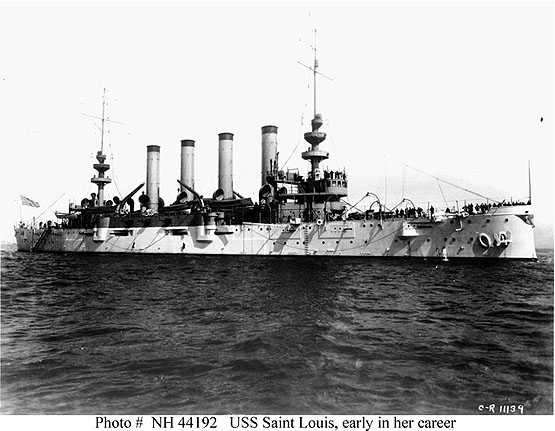United States Navy | |||||||||||||||||||||||||||||||||||||||||||||
Submarine Tenders | |||||||||||||||||||||||||||||||||||||||||||||
|  |
| The fourth St. Louis, Cruiser No. 20, was launched on 6 May 1905 by Neafie & Levy Co., Philadelphia, Pa.; sponsored by Miss Gladys Bryant Smith; and commissioned on 18 August 1906, Captain Nathaniel R. Usher in command. Assigned to the Pacific Fleet, St. Louis departed Tomkinsville, N.Y., on 15 May 1907 following completion of her trials along the Virginia coast. St. Louis called at Port Castries, Bahia, Rio de Janeiro, Montevideo, Punta Arenas, Valparaiso, Callao, and Acapulco before arriving at San Diego on 31 August 1907. Operating off the west coast into the spring of 1908, she steamed from Puget Sound to Honolulu in June, then cruised in Central American waters from July to October. On 5 November 1909, St. Louis returned to Puget Sound and was placed in reserve on 14 November. Decommissioned on 3 May 1910, St. Louis was recommissioned, in reserve, on 7 October 1911 at the Puget Sound Navy Yard. She departed Puget Sound on 13 July 1911 for San Francisco and brief service as receiving ship there. After undergoing repairs, 22 July 1911 to 28 February 1912, she joined the Pacific Reserve Fleet again on 12 March. From 14 July 1912 until 26 April 1913, she operated in support of the Oregon Naval Militia, then returned to the Puget Sound Navy Yard to be placed in the Pacific Reserve Fleet for a year. She departed Puget Sound on 24 April 1914 and commenced her next assignment as receiving ship at San Francisco on the 27th. Returning north to Bremerton, St. Louis was again placed in the Pacific Reserve Fleet on 17 February 1916. Detached from the Reserve Fleet on 10 July 1916, St. Louis departed Puget Sound on 21 July for Honolulu. Arriving at Pearl Harbor on 29 July, she commenced her next duty assignment as tender, Submarine Division Three, Pacific Fleet, with additional duty as station ship, Pearl Harbor. When it became evident that the crew of the interned German sloop Geier intended to scuttle their ship, an armed party from St. Louis boarded the ship on 4 February 1917 and seized her. Geier subsequently served the United States as Schurz (q.v.). Placed in reduced commission on 6 April 1917, as the United States entered World War I, St. Louis departed Honolulu on 9 April to join the cruiser force engaged in escorting convoys bound for Europe. Calling first at San Diego, she took on board 517 National Naval Volunteers and apprentice seamen to bring her war complement to 823 officers and men; and, on 20 April, she was placed in full commission. A month later, she arrived in the Panama Canal Zone; embarked the 7th, 17th, 20th, 43d, 51st, and 55th companies of Marines; transported them to Santiago de Cuba; then sailed for Philadelphia, arriving on 29 May 1917. St. Louis' first convoy duty began on 17 June 1917 when she departed New York in escort of Group 4, American Expeditionary Force. Returning to Boston for repairs on 19 July 1917, she had completed six additional voyages, escorting convoys bound from New York for ports in Britain and France by the end of the war. After the Armistice, St. Louis was immediately pressed into service returning troops to the United States. She returned 8,437 troops to Hoboken, New Jersey, from Brest, France, in seven round-trip crossings between 17 December 1918 and 17 July 1919 when she arrived at the Philadelphia Navy Yard for repairs. Designated CA-18 on 17 July 1920 and assigned to postwar duty with the European Squadron, St. Louis departed Philadelphia on 10 September 1920 for Sheer-ness, Cherbourg, and Constantinople. She disembarked military passengers at Sheerness on 26 September, then continued on to the Mediterranean and reported to the Commander, United States Naval Forces in Turkish Waters at Constantinople on 19 October. Standing up the Bosphorus from Constantinople on 13 November, St. Louis embarked refugees at Sevastopol and Yalta, returning them to Constantinople on 16 November. The following day, her crew formed boat landing parties to distribute food among refugees quartered aboard naval transports anchored in the Bosphorus. St. Louis continued her humanitarian duties at Constantinople and at Anatolian ports during the time of unrest caused by the Russian Civil War and the Turkish Revolution. She departed Asia Minor for Naples on 19 September 1921. She next called at Gibraltar; and, on 11 November, arrived at Philadelphia where, on completion of pre-inactivation overhaul, she was decommissioned on 3 March 1922. In reserve until struck from the Navy list on 20 March 1930, St. Louis' hulk was sold for scrapping on 13 August in accordance with the provisions of the London Treaty for the limitation and reduction of naval armament. |  | St. Louis (Cruiser No. 20) before World War I, in the gray paint adopted at the end of 1908. Authorized in 1900 as protected cruisers, St. Louis and her sisters Milwaukee and Charleston [which also did submarine tender duty -ed] were built as "semi-armored cruisers" with a light waterline armor belt in addition to the sloped ballistic deck built into the usual protected cruiser. They mounted 6-inch guns in single mounts forward and aft on the main deck, and in broadside casemates on two levels amidships; 3-inch guns were carried in superstructure mounts and in hull casemates toward the bow and stern. | History from the Dictionary of American Fighting Ships. | USS Charleston | Table of Ships | Go to TenderTale Main Page | © 2006 Common Cents Computers |